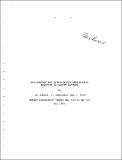Qualitative and quantitative reliability analysis of safety systems
Author(s)
Karimi, Roohollah
DownloadMIT-EL-80-015-06849216.pdf (10.49Mb)
Metadata
Show full item recordAbstract
A code has been developed for the comprehensive analysis
of a fault tree.' The code designated UNRAC (UNReliability
Analysis Code) calculates the following characteristics of an
Tnput fauTt tree:
a) minimal cut sets,
b) top event unavailability as point estimate and/or
in time dependent form,
c) quantitative importance of each component
involved, and
d) error bound on the top event unavailability
UNRAC can analyze fault trees, with any kind of gates (EOR,
NAND, NOR, AND, OR), up to a maximum of 250 components and/or
gates.
For generating minimal cut sets the method of bit manipu-
lation is employed. In order to calculate each component's
time dependent unavailability, a general and consistent set of
mathematical models is developed and the repair time density
function is allowed to be represented by constant, exponen-
tial, 2nd order erlangian and log-normal distributions. A
normally operating component is represented by a three-state
model in order to be able to incorporate probabilities for
revealed faults, non-revealed faults and false failures in
unavailability calculations.
For importance analysis, a routine is developed that will
rearrange the fault tree to evaluate the importance of each
component to system failure, given that a component and/or a
sub-system is unavailable (ie. down or failed). The impor-
tance of each component can be evaluated based on the instan-
taneous or average unavailabilities of each components. To
simulate the distribution of top event uncertainty, a Monte-
Carlo sampling routine is used. This method allows the user
to input uncertainties on the component's failure characteri-
stics (ie. failure rate, average test time, average repair time, etc.) and assign different distributions for subsequent
simulation.
The code is benchmarked against WAMCUT, MODCUT, KITT,
BIT-FRANTIC and PL-MODT. The results showed that UNRAC pro-
duces results more consistent with the KITT results than
either BIT-FRANTIC or PL-MODT. Overall it is demonstrated
that UNRAC is an efficient and easy to use code and has the
advantage of being able to do a complete fault tree analysis
with this single code.
Date issued
1980-05Publisher
MIT Energy Laboratory
Other identifiers
06849216
Series/Report no.
MIT-EL80-015
Keywords
Reliability (Engineering) |x Computer programs, Reliability (Engineering) |x Mathematical models, Trees (Graph theory)